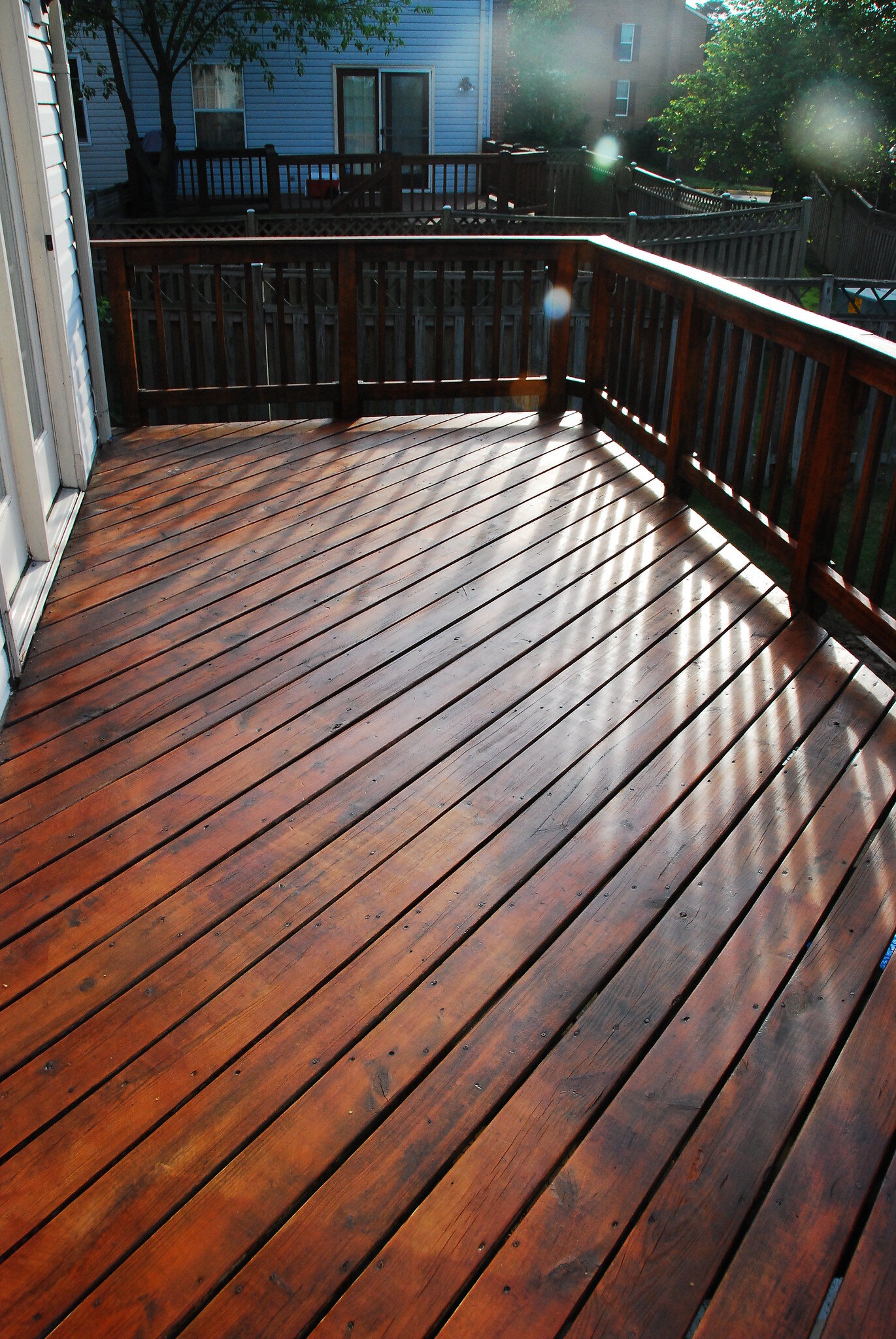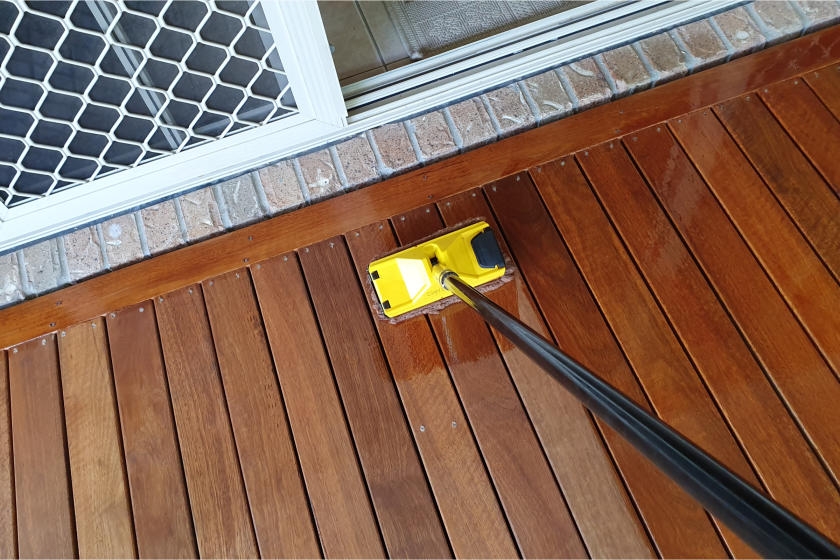Water-Based Stains for Your Deck: Advantages and Applications
Water-Based Stains for Your Deck: Advantages and Applications
Blog Article
A Comprehensive Overview to Various Kinds Of Deck Staining Techniques for Ultimate Security and Appearances
In the world of deck upkeep, the art of discoloring stands as a critical action towards both preserving the honesty of your outside area and improving its visual allure. As we browse through the complex world of deck staining techniques, one starts to appreciate the nuanced strategies that can make all the difference between a mediocre finish and a remarkable one. From the choice of the ideal tarnish kind to the precise application approaches, each facet plays an important role in accomplishing that best balance in between protection and aesthetic appeals. Join us as we uncover the keys behind attaining the ultimate deck discoloration results-- a journey where every brushstroke shapes not just the surface area, yet the really essence of your exterior sanctuary.
Recognizing Various Kinds Of Discolorations
Different kinds of stains are frequently made use of in the process of deck staining to achieve various visual and safety effects. On the various other hand, semi-transparent discolorations use a balance between color enhancement and defense, allowing some wood grain to show through.
Toners add a hint of color to the timber while giving very little defense, making them appropriate for newer decks with much less wear. Understanding the qualities and advantages of each type of discolor is crucial for accomplishing the preferred look and toughness for your deck.
Picking the Right Spot Color
When considering the aesthetics of your deck discoloration task, the selection of tarnish color plays a vital duty in boosting the protective qualities of the picked tarnish type (Beautiful Deck). The shade you select can substantially influence the overall look of your deck, as well as its ability to stand up to the components gradually
When choosing a tarnish shade, it's necessary to think about the existing color design of your home's outside. Integrating the deck discolor with the overall aesthetic of your home can produce a natural and aesthetically attractive outdoor room. In addition, the shade of your deck discolor can influence the temperature of the deck surface; darker shades tend to absorb even more warmth, while lighter colors show sunshine and stay cooler.
In addition, the type of timber you are discoloring will also influence how the discolor shade shows up. Different wood species can engage with the tarnish in numerous ways, possibly changing the final color. It's recommended to examine the discolor on a tiny, inconspicuous location of the deck to make certain the shade ends up as desired prior to proceeding with the whole task.
Preparing Your Deck for Staining
To make certain a successful and resilient deck staining task, complete prep work of the deck surface area is vital. Begin by cleansing the deck thoroughly to remove dirt, grime, mildew, and any old tarnish or end up. Utilize a deck cleaner or a combination of water and detergent along with a stiff brush or pressure washer to scrub the surface clean. After cleansing, permit the deck to completely dry totally prior to proceeding to the following step.
Examine the deck for any kind of damaged or rotten boards that require to be changed. Hammer down any sticking out nails and sand any harsh areas to make certain a smooth surface area for discoloration. Check for any type of loosened railings or steps that may require tightening or repair service.
Once the deck is tidy, dry, and in good fixing, think about using a wood brightener to restore the deck's natural shade and open up click to read the wood pores for better tarnish infiltration. Finally, shield any kind of close-by plants, furniture, or surface areas with plastic sheeting prior to proceeding with the staining procedure. Proper preparation is crucial to achieving a professional-looking finish and optimizing the long life of your deck stain.
Using Stain With Various Techniques
For a flawless and professional finish, the approach of applying tarnish plays a critical function in enhancing the look and toughness of your deck. There are several techniques you can utilize to guarantee an effective application of discolor.
It is ideal for detailed areas and reaching between deck boards. Back-brushing after rolling is advised to also out the discolor and function it right into check the wood for much better infiltration.
Spraying is an additional popular method, supplying speed and ease of application, especially for huge deck locations. It is very important to utilize a high-quality sprayer and be conscious of overspray. Pad applicators give a smooth and also end up and are suitable for both vertical and horizontal surface areas. Whichever technique you pick, making sure proper prep work and adhering to supplier guidelines will certainly assist attain a resilient and stunning discolor coating on your deck.

Maintaining and Re-staining Your Deck
When it comes to re-staining your deck, the frequency depends on various elements such as the type of tarnish used, the climate in your location, and exactly how much wear and tear your deck experiences. Normally, it is advised to re-stain your deck every 2-4 years to keep its security and visual appeals.
Before re-staining, guarantee the deck is clean, completely dry, and without any previous discolor residue. Fining sand may be required to smooth out rough areas or get rid of old tarnish that is flaking. Pick a high-grade tarnish that suits your deck's product and provides the preferred degree of security. Use the discolor uniformly using the appropriate technique gone over earlier in this overview to make certain a long-lasting and gorgeous coating - Water-Based Stains. By remaining positive with upkeep and re-staining, you can appreciate a aesthetically appealing and well-protected deck for many years ahead.
Verdict
To conclude, recognizing the various sorts of deck stains, choosing the appropriate shade, appropriately preparing the deck, applying stain with various strategies, and re-staining the deck and preserving are essential actions for ultimate defense and aesthetics. By complying with these steps, you can make certain that your deck remains in top condition for many years to find.
Furthermore, the shade of your deck discolor can influence the temperature level of the deck surface; darker shades he said tend to absorb more warm, while lighter shades reflect sunlight and remain cooler.
It's suggested to evaluate the discolor on a little, unnoticeable area of the deck to guarantee the color turns out as wanted before continuing with the whole task.

Report this page